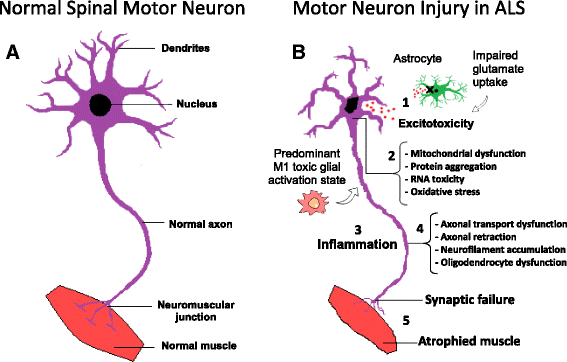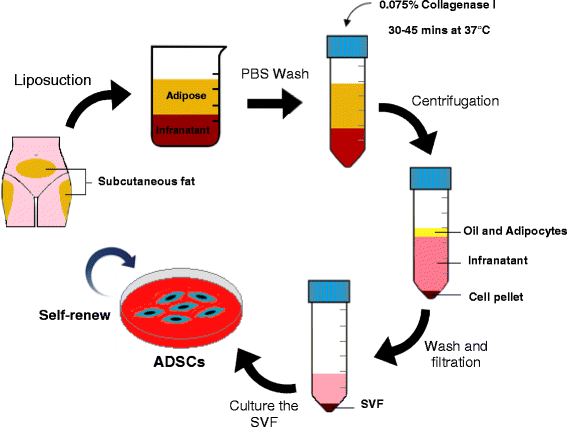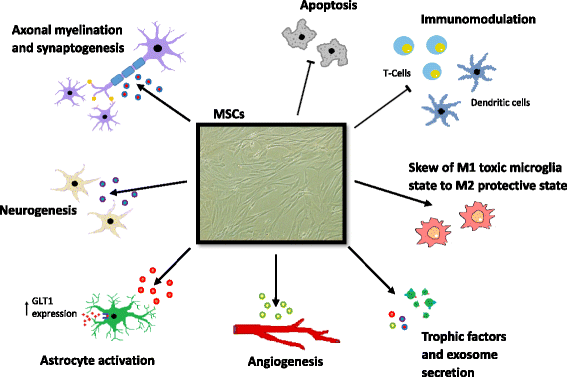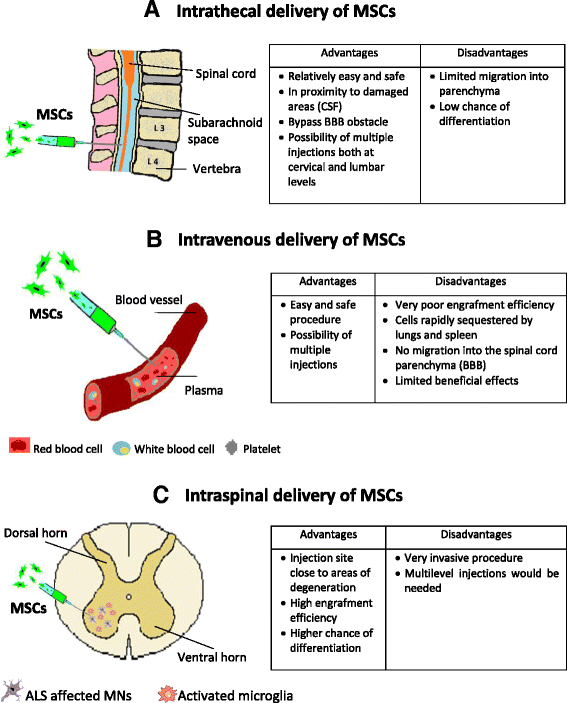Advances, challenges and future directions for stem cell therapy in amyotrophic lateral sclerosis
- PMID: 29132389
- PMCID: PMC5683324
- DOI: 10.1186/s13024-017-0227-3
Advances, challenges and future directions for stem cell therapy in amyotrophic lateral sclerosis
Abstract
Amyotrophic lateral sclerosis (ALS) is a rapidly progressive neurodegenerative condition where loss of motor neurons within the brain and spinal cord leads to muscle atrophy, weakness, paralysis and ultimately death within 3-5 years from onset of symptoms. The specific molecular mechanisms underlying the disease pathology are not fully understood and neuroprotective treatment options are minimally effective. In recent years, stem cell transplantation as a new therapy for ALS patients has been extensively investigated, becoming an intense and debated field of study. In several preclinical studies using the SOD1G93A mouse model of ALS, stem cells were demonstrated to be neuroprotective, effectively delayed disease onset and extended survival. Despite substantial improvements in stem cell technology and promising results in preclinical studies, several questions still remain unanswered, such as the identification of the most suitable and beneficial cell source, cell dose, route of delivery and therapeutic mechanisms. This review will cover publications in this field and comprehensively discuss advances, challenges and future direction regarding the therapeutic potential of stem cells in ALS, with a focus on mesenchymal stem cells. In summary, given their high proliferation activity, immunomodulation, multi-differentiation potential, and the capacity to secrete neuroprotective factors, adult mesenchymal stem cells represent a promising candidate for clinical translation. However, technical hurdles such as optimal dose, differentiation state, route of administration, and the underlying potential therapeutic mechanisms still need to be assessed.
Keywords: Adipose derived stem cells; Amyotrophic lateral sclerosis; Neurodegeneration; Stem cell transplantation.
Conflict of interest statement
Ethics approval and consent to participate
Not applicable.
Consent for publication
Not applicable.
Competing interests
The authors declare that they have no competing interests.
Publisher’s Note
Springer Nature remains neutral with regard to jurisdictional claims in published maps and institutional affiliations.
Figures




Similar articles
-
The past, present and future of stem cell clinical trials for ALS.Exp Neurol. 2014 Dec;262 Pt B:127-37. doi: 10.1016/j.expneurol.2014.02.021. Epub 2014 Mar 6. Exp Neurol. 2014. PMID: 24613827 Review.
-
Concise review: Stem cell therapies for amyotrophic lateral sclerosis: recent advances and prospects for the future.Stem Cells. 2014 May;32(5):1099-109. doi: 10.1002/stem.1628. Stem Cells. 2014. PMID: 24448926 Free PMC article. Review.
-
Stem cell therapy in amyotrophic lateral sclerosis.J Clin Neurosci. 2013 Dec;20(12):1659-63. doi: 10.1016/j.jocn.2013.04.024. Epub 2013 Oct 19. J Clin Neurosci. 2013. PMID: 24148693 Review.
-
Overview of stem cells therapy in amyotrophic lateral sclerosis.Neurol Res. 2021 Aug;43(8):616-632. doi: 10.1080/01616412.2021.1893564. Epub 2021 Feb 25. Neurol Res. 2021. PMID: 33632084 Review.
-
Stem cells in amyotrophic lateral sclerosis: motor neuron protection or replacement?CNS Neurol Disord Drug Targets. 2010 Jul;9(3):314-24. doi: 10.2174/187152710791292666. CNS Neurol Disord Drug Targets. 2010. PMID: 20406179 Review.
Cited by
-
Rebuilding hippocampus neural circuit with hADSC-derived neuron cells for treating ischemic stroke.Cell Biosci. 2022 Apr 4;12(1):40. doi: 10.1186/s13578-022-00774-x. Cell Biosci. 2022. PMID: 35379347 Free PMC article.
-
Adipose Tissue Stem Cells for Therapy: An Update on the Progress of Isolation, Culture, Storage, and Clinical Application.J Clin Med. 2019 Jun 26;8(7):917. doi: 10.3390/jcm8070917. J Clin Med. 2019. PMID: 31247996 Free PMC article. Review.
-
Intrathecal Transplantation of Autologous and Allogeneic Bone Marrow-Derived Mesenchymal Stem Cells in Dogs.Cell Transplant. 2021 Jan-Dec;30:9636897211034464. doi: 10.1177/09636897211034464. Cell Transplant. 2021. PMID: 34427495 Free PMC article.
-
Adipose-derived stem cells protect motor neurons and reduce glial activation in both in vitro and in vivo models of ALS.Mol Ther Methods Clin Dev. 2021 Mar 27;21:413-433. doi: 10.1016/j.omtm.2021.03.017. eCollection 2021 Jun 11. Mol Ther Methods Clin Dev. 2021. PMID: 33869658 Free PMC article.
-
Stem Cell Therapy for the Treatment of Amyotrophic Lateral Sclerosis: Comparison of the Efficacy of Mesenchymal Stem Cells, Neural Stem Cells, and Induced Pluripotent Stem Cells.Biomedicines. 2024 Dec 27;13(1):35. doi: 10.3390/biomedicines13010035. Biomedicines. 2024. PMID: 39857620 Free PMC article. Review.
References
-
- Walling AD. Amyotrophic lateral sclerosis: Lou Gehrig's disease. Am Fam Physician. 1999;59(6):1489–1496. - PubMed
Publication types
MeSH terms
Grants and funding
LinkOut - more resources
Full Text Sources
Other Literature Sources
Medical
Miscellaneous

